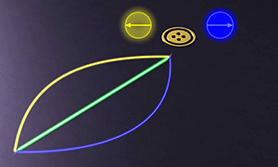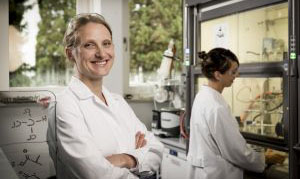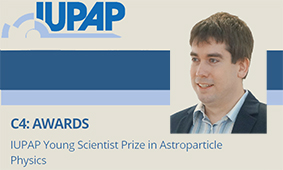 Adv.Materials: process glass like a polymer Adv.Materials: process glass like a polymerThe young investigator group of Bastian Rapp has developed a new forming technology to structure quartz glass. The scientists mix nanometer-sized glass particles with a liquid polymer, form the mix like a sponge cake, and harden it by heating or light exposure. The polymers act like a strong bonding agent and, thus, the resulting solid can be milled, turned, laser-machined or processed like any polymer. Once the final structure is attained, the residing polymer is burned to CO2 and the remaining glass particles are sintered and densified to pore-free quartz glass. Glassomer |
 YIN Insight 2016/17 online with news and reports YIN Insight 2016/17 online with news and reportsNew developments like the Tenure Track Program and the first round of the Excellence Strategy directly impact the career of young investigators. As YIN, we participate, speak with a common voice and try help to shape a better future for science. In our annual magazine, we discuss the Tenure Track Program and review the KIT Associate Fellow. Moreover, new facts and figures show the amount of work and goals achieved by YIN, e.g. the amount of subsequent funding acquired and the number of course hours’ taught. We also report about YIN activities, new members and alumni. YIN Insight 2016/17 |
 PlosONE and ex-nature editor at YIN fireside chat PlosONE and ex-nature editor at YIN fireside chatData availability, source code sharing and credit taxonomy for authors are essential in open access publishing. These requirements give rise to a whole set of new questionsthat vary for each discipline: What is the minimum data set and where to store it? How can specially programmed software tools be maintained sustainably over time? And which are the right criteria to weigh and describe each author’s input? Leonie Mück gave some answers that sprang a lively discussion with the YIN members. She worked as senior editor for NATURE until August 2017 when she joined the non-profit open access journal PLOS ONE. |
 ncomms: one step towards quantum simulators ncomms: one step towards quantum simulatorsPhysicists at KIT have developed a crucial component for a quantum simulating. They represented the light-matter-interaction of photosynthesis using electromagnetic resonators for the photons and superconducting circuits as quantum bits for the atoms. “We succeeded in getting both the quantum bit and the resonator to assume two opposite states at the same time,” says Martin Weides, co-author and YIN member. Due to this effect, quantum simulators solve a problem much faster than conventional computers which store infor-mation either as zero or one. article on ncomms |
 Oct 10 - YIN Lecture No 6: Supermassive Black Holes Oct 10 - YIN Lecture No 6: Supermassive Black HolesBlack holes of more than a million solar masses form the centers of many galaxies. In the 6th YIN Lecture, Prof. Guinevere Kauffmann will talk about the observable evidence for their existence. At those sites of extreme gravity, in falling matter is efficiently converted into radiation visible across the electromagnetic spectrum. Large surveys of galaxies across the Universe suggest that black holes not only swallow large quantities of matter but also dump energy into their host galaxies and regulate their growth. The lecture starts at 17:45 in Fritz-Haller-Hall, bldg. 30.10. YIN Lecture Series |
 ERC Starting Grant for Cornelia Lee-Thedieck ERC Starting Grant for Cornelia Lee-ThedieckYIN member Cornelia Lee-Thedieck develops models of the human bone marrow to study the regeneration of blood and bone by stem cells and how this regeneration is disturbed in diseases like leukemia or bone metastases. The European Research Council now funds her research project “Blood and Bone – Conjoined Twins in Health and Disease: Bone Marrow Analogs for Hematological and Musculoskeletal Diseases” with EUR 1.5 million for five years. Understanding the mutual interactions of blood and bone might be the key to restore their regenerative potential. Press info |
 Advanced Science: self- healing gold particles Advanced Science: self- healing gold particlesSelf-healing materials can counter mechanical damages by readopting their former shape. Scientists now found this capacity in pure gold particles. Gold has, thus, become the first known metal where, upon heating, the atoms start to slowly fill in sustained dents or scratches. “Our results may lead to more robust components for structures smaller than one thousandth of a millimeter,” says Christian Brand. His young investigator group together with scientists from the Technion - Israel Institute of Technology has published a report in Advanced Science. Advanced Science |
 YIN member gets IUPAP Young Scientist Prize YIN member gets IUPAP Young Scientist PrizeFor his outstanding contributions, Frank Schröder received the IUPAP Young Scientist Prize in Astroparticle Physics. In particular, he experimentally determined the sensitivity of the radio signal to air showers: When colliding with earth's atmosphere, cosmic rays set free cascades of smaller particles and, thereby, produce light as well as radio waves. While light observations are limited to clear, dark nights, radio emissions can always be measured. Representing 60 member states, IUPAP is one of the largest international physics organizations. IUPAP |
 First Associate Fellow at the KIT Faculty CIW/VT First Associate Fellow at the KIT Faculty CIW/VTThe KIT Department of Chemical and Process Engineering announced Emin Azad to be the first KIT junior research group leader to become Associate Fellow. Besides establishing the official award procedure, the KIT department has also changed its PhD regulations: Since June 2017, KIT Associate Fellows have the right to be involved in supervising and reviewing PhD theses. The future will show what this de facto entails. In any case, it is an important step towards further independence of junior research group leaders. PhD regulations |
 Faculty Teaching Award for YIN alumnus Faculty Teaching Award for YIN alumnusFor the lecture on material process technology, YIN alumnus Kay Weidenmann, together with Joachim Binder, receives the Faculty Teaching Award in mechanical engineering. Therewith, KIT honors the excellent achievements of both lecturers: They especially attached importance to the close interconnection of theory and application. Thus, their lecture was complemented by practical courses in small groups at three laboratories. The prize, endowed with 10 000 Euro, is annually announced within each of the 11 KIT-faculties. Video portrait at 9:40 |
 Nature: 3D-printing in glass - Hannover Fair H2-B16 Nature: 3D-printing in glass - Hannover Fair H2-B16For 3-D-printing, glass needs to be liquid at room temperature. To this aim, the research group of Dr. Bastian Rapp mixes nanoparticles of ultrapure fused silica glass with a liquid monomer. They harden the mixture at certain points using stereolithography 3D printers and wash out the remaining liquid material in a solvent bath. The resulting structure measures only a few tens of micrometers. It, then, gets heated up to a point where the monomer dissolves and the glass particles fuse. Science and industry alike profit from glass microstructures. NeptunLab |
 Pulsed metallurgy for new compound materials Pulsed metallurgy for new compound materials“We want to develop metallic thin films as nanostructured compound materials with customized properties,” explains Karsten Woll, Emmy Noether group leader and newly elected YIN member. He uses electric impulses of less than a millisecond to precisely impress high heating and cooling rates on the material. Thereby, the thin film gets structured on nano-scale within split seconds. The emerging micro structures determine the mechanical properties. They can be precisely tailored in a broad range and, thus, optimally adjusted for application. More |
 YIN goes Physics Journal: Permanently on fixed term YIN goes Physics Journal: Permanently on fixed termOpinionated and knowledgeable, YIN outlines the situation of junior scientists in the Physics Journal published by the German Physical Society (DPG). Based on numbers from the Federal Statistics Office, YIN takes a closer look at dwindling chances to obtain a permanent academic position and a decreasing demand for PhD holders from industry. High-skilled academics without clear career perspectives are not seldom too old, one legged, or over educated to switch sides – women are hit harder. Physics Journal |
